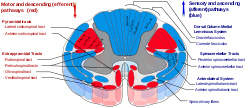Extrapyramidal motor system
| Extrapyramidal system | |
|---|---|

Medulla spinalis. (Extrapyramidal tracts are labeled as a group in red, at bottom left.)
|
|
| Details | |
| Identifiers | |
| Latin | Systema extrapyramidale |
| MeSH | Extrapyramidal+tracts |
| NeuroNames | ancil-623 |
| Dorlands /Elsevier |
s_33/12787420 |
|
Anatomical terms of neuroanatomy
[]
|
|
In anatomy, the extrapyramidal system is a biological neural network that is part of the motor system causing involuntary movements. The system is called "extrapyramidal" to distinguish it from the tracts of the motor cortex that reach their targets by traveling through the "pyramids" of the medulla. The pyramidal pathways (corticospinal and some corticobulbar tracts) may directly innervate motor neurons of the spinal cord or brainstem (anterior (ventral) horn cells or certain cranial nerve nuclei), whereas the extrapyramidal system centers on the modulation and regulation (indirect control) of anterior (ventral) horn cells.
Extrapyramidal tracts are chiefly found in the reticular formation of the pons and medulla, and target lower motor neurons in the spinal cord that are involved in reflexes, locomotion, complex movements, and postural control. These tracts are in turn modulated by various parts of the central nervous system, including the nigrostriatal pathway, the basal ganglia, the cerebellum, the vestibular nuclei, and different sensory areas of the cerebral cortex. All of these regulatory components can be considered part of the extrapyramidal system, in that they modulate motor activity without directly innervating motor neurons.
The extrapyramidal tracts include parts of the following:
...
Wikipedia
